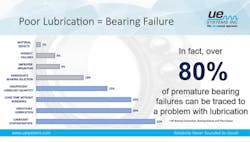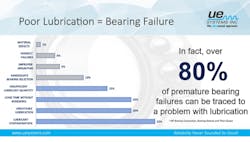How to implement an ultrasound program at your plant
Adrian Messer is the Manager of U.S. Operations for UE Systems, Inc. For more than a decade, Messer has been helping facilities around the country transform their reliability programs by successfully implementing ultrasound technology for condition monitoring and energy conservation applications. During the Q&A portion of the webinar, “Ultrasound Assisted Lubrication” Messer described the many uses for ultrasound technology and how to roll out a program at your facility.
PS: Do you need to set a baseline decibel level in order to start a bearing lubrication program with ultrasound?
AM: No, you don't. I talked a lot about establishing baselines, and that really is the point where you'd like to eventually get. I know just starting out, you have to think, “We haven't currently been monitoring these assets, so how do I know if what I'm listening to is good or bad?”
One of the quickest ways to get a handle as to what's good and what's bad is just by simply doing a comparison. We compare decibel level readings on identical points on identical machines, and that'll give us a really good, quick indicator as to what's good and what's bad.
When it comes to setting baselines, the first reading that you take and download, the software will set that reading as the baseline. But we really recommend a more “historical approach” where we establish an initial trend.
Let's say when we first set up our route, we want to go out and take a reading once a week for a month. So we take four or five good readings, and then at that point, we can set any of those readings as our baseline. It's very easy to change the baseline from one reading to the next.
It would also be a good practice to take a grease gun out with you so when taking those initial readings. If there are any points along that route to where the decibel level fails as we applied grease, that would be a really good reading to take and use as the baseline because that bearing was already in need of lubrication.
PS: How do you start an ultrasound program even if you don't have a PdM program in place?
AM: Ultrasound tends to be a really good fit in those kinds of environments because of the versatility. The same instrument that we could use for bearing monitoring is the same instrument that we can use for leak detection. It's the same instrument we can use for steam trap and valve monitoring.
It's very easy to put ultrasound into those more reactive kinds of environments to where we're not currently doing anything, any kind of condition monitoring. To even further help that, we have available for download on our website some written procedures on how ultrasound can be used and implemented for each one of those main applications.
The ISO 29821 standard (Condition Monitoring and Diagnostics of Machines — Ultrasound) would be a good document to get if you're looking to start up an ultrasonic program. But ultimately, a lot of people will default to just simply understanding asset criticality and understanding the assets that we want to monitor. Once we know those assets, then we can understand how those assets can fail, and then what technology can be deployed that we'll find that failure mode as early as we need it to find.
PS: What are the most common route frequencies that you've come across?
AM: On average, what we tend to see is people running routes on their assets once a month. They're going out once a month and taking readings. Now, if you've trended something for a year and you've seen no change in DB, nothing's reached an alarm level, then maybe we can consider backing off and doing every other month. But again, a lot of it just depends on criticality. But I would say on average, we see people running routes once a month.
PS: Can you use ultrasound technology to indicate damage in things like conveyor belts, chains, and the belts that they are turning?
AM: We have seen people use airborne ultrasound on conveyor type bearings and rolling rollers. When one of those types of bearings or rollers starts to go bad, it will actually give off airborne high-frequency sounds. It'll actually sound like a crackling and popping sound.
We see that a lot in mining where you may have miles of rollers, miles of conveyors. You see it in distribution type facilities where again, you've got miles of rolling rollers and conveyor type bearings. There's no way that you can make contact with every single one of those, so we can just do a quick airborne scan of that conveyor, or those rollers or conveyor bearings.
If we hear one that is going bad, then once we've narrowed down that area, we can go in and pinpoint exactly which one it is that's making that noise.


